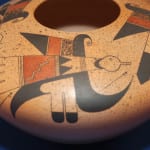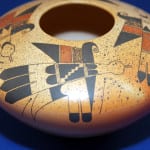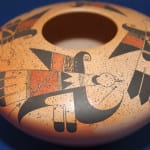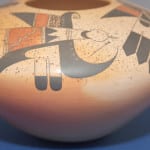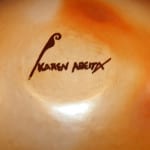This pot is uniform and thin with a beautiful shape painted with four Sikyatki-derived birds. The narrow base flairs out to maximum width and then forms a wide shoulder as it curves back to the opening. The shape gives the jar an upward thrust that supports the flock of four birds flying around the shoulder in a counterclockwise direction. The jar below the shoulder is richly blushed from the firing.
The upper wing and heads of the four birds are the same, but there is variation of design forming two pairs of avian images. On one the body core is red and the lower wing forward thrusting. The other pair of birds has a black body core and downward-pointing lower wings. Cutting through the core of each bird is a stepped thunder image, though this is depicted with two variations. Associated with all four birds are dragonfly symbols. The flight path of the birds is speckled with black paint.
As always it may be misleading to read interpretations into design, but the black speckling is a Sikyatki technique that is frequently said to indicate rain. Dragonflies are also identified with water. The feathers of birds carry those prayers upwards. As with much Hopi iconography, the design seems to be related to the hope for rain.
Pot 2010-24 is directly copied from a Sikyatki polychrome jar in the Keam collection of the Peabody Museum, Harvard whose image is reproduced in Wade (1980b:26), a photograph, and Patterson (1994:50, 141, 155, 230), drawings. Both Alexander Stephen in his 1884/1894 catalog of the collection and Ed Wade in his 1980 catalog of the collection offer extensive discussion of the Sikyatki pot that was the model for 2010-24:
Stephen: “The subject, repeated four times, is the mythic Um-tok-ina, the Thunderer: It is depicted with the head of the serpent genius Baholikonga [whose] body is a rain cloud with lightening darting through it, which discloses the origin of the angular cloud symbol so universally depicted upon all classes of their pottery. The tail is that of the eagle; the wings carry the storm clouds and attached to the lower wing are the clouds conveying the rain. The singular horn shaped object upon which the hail annulets are incised, passing behind the neck and curving over the head, is the source of thunder….(T)his singular mythic animal….has never been seen, but is known to be the active element of the thunder storm….(I)t is painted upon an alter when the men invoke …aid.., which is only in time of long continued drought. The little objects painted upon the vase below the birds are Batolatci (dragon flies)….(D)ragon flies have always been held in great veneration by the Mokis (Hopi) and their ancestors, as they have often been sent by Omau to reopen springs (of water) which Mu-ing-wa had destroyed, and to confer other blessings upon the people (Wade, 1980b:26).” (Wade quotes from Patterson, 1994:49.)
Wade adds: “The encircling decorative band of toothed birds (or ‘Thunderers’), surrounded by darting dragonflies suggests ceremonial kiva wall murals. Unquestionably certain Sikyatki vessels served as the early historic equivalent of prehistoric kiva jars, and Stephen’s interpretation of these unique designs reinforces the possibility that this vessel may have possessed ritual significance (Wade, 1980b:26)”
Stephen repeats a Hopi teaching story about how dragonflies (batolatci) helped to magically grow corm for the Hopi when they were starving during the migrations before they reached the Hopi mesas (Patterson, 1994:50-51).
This pot is one of a group of pots that were part of a 2,400 item Southwest pueblo pottery collection that was assembled by Rutt Bridges of Denver, CO over a period of about 14 years. His sister, Kathleen Hoff, is helping her brother sell the collection. In 2009 Kat sent me two CDs with information about Hopi pots in the collection. During 2010, over a period of months Kay sent me additional photographs of about 200 Hopi and Hopi/Tewa pots from the collection.




